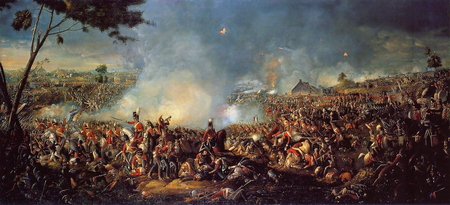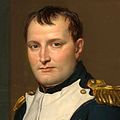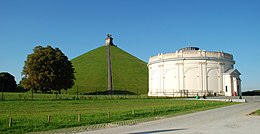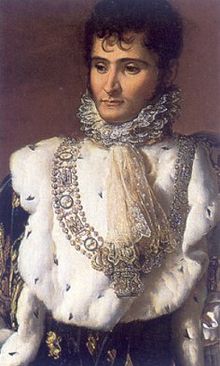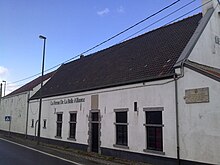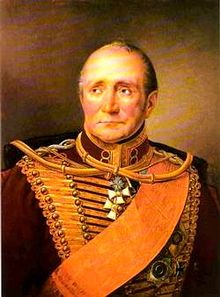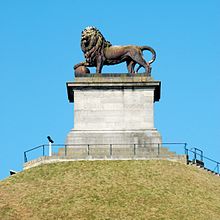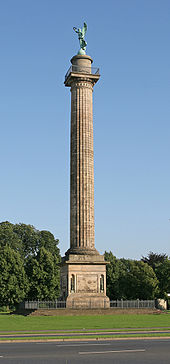Battle of Waterloo
| date | June 18, 1815 |
|---|---|
| place |
Waterloo , then the Netherlands , now Belgium 15 km south of Brussels |
| output | Coalition victory |
| Parties to the conflict | ||
|---|---|---|
| Commander | ||
| Troop strength | ||
| 72,047 men of which: 48,950 infantry 15,765 cavalry 7,332 men with 246 guns |
67,661 men : 49,608 infantry 12,408 cavalry 5,645 men with 156 guns |
48,000 men |
| losses | ||
|
25,000 dead and wounded, |
15,000 dead and wounded |
7,000 dead and wounded |
Spring campaign 1813
Lüneburg - Möckern - Halle - Großgörschen - Gersdorf - Bautzen - Reichenbach - Nettelnburg - Haynau - Luckau
Autumn campaign 1813
Großbeeren - Katzbach - Dresden - Hagelberg - Kulm - Dennewitz - Göhrde - Altenburg - Wittenberg - Wartenburg - Liebertwolkwitz - Leipzig - Torgau - Hanau - Hochheim - Danzig
Winter campaign 1814
Épinal - Colombey - Brienne - La Rothière - Champaubert - Montmirail - Château-Thierry - Vauchamps - Mormant - Montereau - Bar-sur-Aube - Soissons - Craonne - Laon - Reims - Arcis-sur-Aube - Fère-Champenoise - Saint -Dizier - Claye - Villeparisis - Paris
Summer campaign of 1815
Quatre-Bras - Ligny - Waterloo - Wavre - Paris
The battle of Waterloo [ ˈvɑtɐloː ] on June 18, 1815 was the last battle of Napoleon Bonaparte . It took place around 15 km south of Brussels near the village of Waterloo , which then belonged to the Kingdom of the United Netherlands and is now in Belgium .
The defeat of the French led by Napoleon against the Allied troops under the English General Wellington and the Prussian Field Marshal Blücher ended Napoleon's rule of the Hundred Days and, with his final abdication on June 22, 1815, led to the end of the French Empire .
After this second complete military defeat within a short period of time, the Second Peace of Paris imposed stricter peace conditions on France . Napoleon himself was brought as a prisoner of war by the British to the Atlantic island of St. Helena , where he died as an exile on May 5, 1821.
The phrase "to experience his Waterloo" as a synonym for total defeat has its origin in this battle.
In the French language it is called Bataille de Waterloo (or more rarely Bataille de Mont-Saint-Jean ); in the English Battle of Waterloo . In Germany, the term battle at Belle Alliance was also common until the 20th century .
Before the Battle of Waterloo, the Congress of Vienna ended on June 9, 1815 with the signing of the Congress Act.
Preparations
Napoleon took over command of the army, but could no longer fall back on his old team: Marshal Louis Alexandre Berthier , his former chief of staff, was dead, and he saw Marshal Joachim Murat as a traitor. Other marshals refused to serve, either for reasons of age or because they were the new King Louis XVIII. had taken an oath of allegiance . Napoleon's appointments in 1815 are often criticized by historians. Marshal Nicolas-Jean de Dieu Soult , a capable self-employed commander, became chief of staff although he was not trained to do so. Marshal Emmanuel de Grouchy should first lead the cavalry, for which he was particularly suitable. He was later given command of the right wing of the army, although he had never commanded a single corps. The left wing was entrusted to Marshal Michel Ney , whose defection from the Bourbons and transition to Napoleon had been of the greatest importance for his triumphal procession to Paris. Ney was considered a fighter, but not a thinker. Marshal Louis-Nicolas Davout , arguably the most capable of the marshals, stayed behind as minister of war to hold Paris for the emperor.
Through French sympathizers in the Netherlands, Napoleon had a clear idea of the troop disposition of his enemies. The armies were grouped in loose corps formation. The Prussians were in the Liege - Dinant - Charleroi - Tienen area . Wellington's army, which in addition to British also comprised Dutch , Hanoverian , Brunswick and Nassau units, was located in the Brussels - Gent - Leuze - Mons - Nivelles area . It could take days to gather such an army. The supply lines of the two armies diverged, those from Wellington to the north, those of Blucher east to Germany. In the event of a surprise attack that would have forced them to retreat, the allies would use these routes to retreat. Napoleon wanted to defeat one army first, then the other, without having to worry about the other. Napoleon's line-up was ideally aligned for such a movement. Two wings under Ney and Grouchy should precede the army and follow Napoleon in the middle, where he could choose to throw the weight on one flank or the other.

On June 15, the French army crossed the border with the Netherlands, and at nightfall Napoleon took quarters in Charleroi . His army was concentrated and stood between the allies. During dinner, Wellington learned from the Prince of Orange that French scouts had reached Quatre-Bras (19 km south of Waterloo), an important crossroads on the army route to meet Blucher. He had anticipated a bypass on his right flank and therefore began to concentrate his army at Nivelles (Nivelles is 11 km west of Quatre Bras, 22 km west of Sombreffe and 16 km southwest of Waterloo). The Dutch commander at Quatre Bras had recognized the importance of the crossroads and disregarded the orders to go to Nivelles. Two brigades now held this intersection, which is 33 km from Brussels. It could be held through the whole of June 16th by the Dutch, the Nassau and gradually arriving British and Brunswick reinforcements ( battle of Quatre-Bras ).
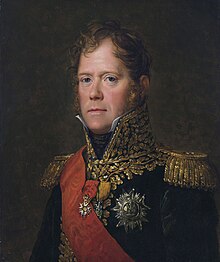
Ney, who saw a slight slope in front of him that led to the intersection, assumed that this was only held by weak forces, but that the allied army was hidden behind it in full strength. His experience in Spain had taught Ney to refrain from attacking Wellington in prepared positions. So he only carried out reconnaissance attacks in the morning and missed the chance to take the intersection before the reinforcements arrived. On the same day the Prussians faced the French attack in a previously scouted position and were defeated in the battle of Ligny . Napoleon was unable to achieve a decisive victory, as the French I. Corps received contradicting orders on the march from Quatre Bras to Ligny and could therefore not be used in the battle of Quatre Bras or Ligny. Thus it was possible for the Prussian troops to evade annihilation and to retreat with a largely intact army.
Field Marshal Blücher was wounded in the battle and almost taken prisoner. The command was therefore led the following night by his chief of staff, Lieutenant General von Gneisenau , who ensured that the retreat did not take place in an easterly direction, as the French expected, but in a northerly direction towards Wavre , from where the Prussians either come to Wellington's aid or themselves could withdraw to the east - a decisive factor for the outcome of the later battle.
After Wellington learned of the defeat of the Prussians in the Battle of Ligny and their retreat on Wavre on the morning of June 17th , he set out from Quatre-Bras at 10 a.m. and took position between the town of Braine-l'Alleud and the Meierhof Papelotte. By the morning of June 18 he had established his main power in two divisions on either side of the road from Charleroi to Brussels on a ridge running from west to east. In front of the front of the right wing was the Hougoumont Castle, in the middle the fortified farm La Haye Sainte , in front of the extreme left wing the farms Papelotte, La Haye and Fichermont.
After the unfortunate outcome of the Battle of Ligny, Wellington had to expect to be attacked by Napoleon's main force and therefore limited himself entirely to defense until the arrival of the Prussians . Napoleon had carefully considered the position of his opponent and did not allow the troops to leave their camps for the night until about ten o'clock in the morning. He set them up about two kilometers from the enemy, so that the infantry formed two meetings and the cavalry a third.
The battle
Battle between the French and British armies
Napoleon's plan was to direct the main attack on Wellington's left wing; a storm on Hougoumont was intended to divert attention from this movement and draw part of the enemy forces there. Because of the rain that had fallen all night, the attack could not begin until 11:30 a.m. Napoleon postponed the attack from 9:00 a.m. to 11:30 a.m., supposedly so that the ground would dry out, which gave the artillery the ability to easily change position and also increased the effect of ricocheting bullets . This is doubted, however, since his troops did not take up their attack positions against the Allies until around 11 a.m. and some not at all before 1 p.m. It therefore seems that the delay ordered is less due to damp soil than to the formation of the units the previous evening, to the exhaustion of the French troops and to the blockage of the only existing approach road. He also failed to send orders to Grouchy early on to move on to Wavre as quickly as possible and keep in touch with him.
The attack on Hougoumont, with which Wellington was to be induced to withdraw troops from the left wing so that the French main thrust could break through it, was to be carried out by the II Corps under General Reille . The advance itself was entrusted to Jérôme Bonaparte and his 6th French infantry division , who had failed as a general in previous campaigns and wanted to re-establish his reputation with a successful conquest of the heavily fortified estate. However, this contradicted Napoléon's tactics , for which the battle for Hougoumont should only attract British troops from the center and the left wing. At 11:30 a.m. Jérôme Bonaparte launched an attack, but the attack got stuck in the pleasure forest in front of it, defended by Dutch and Hanoverian soldiers. Encouraged by Ney, Bonaparte now sent his entire division and, on request, received further troops from Reille who took part in the assault on the homestead. Wellington, however, trusted the court could be held and did not send any assistance. Napoléon's plan was reversed: instead of tying up British troops, the attack on Hougoumont attracted numerous French infantrymen who were missing from the main attack on La Haye Sainte.
Nevertheless, the French overwhelming power succeeded in occupying the Lustwäldchen around 12:30, but this led to even more persistent defense of the forecourt and the homestead itself by a British guards infantry regiment with reinforcements from Brunswick and Nassau detachments. British officers later wrote furiously that the Dutch soldiers who had defended the pleasure forest ran away in a panic after it fell. Instead, it is considered certain that, since there was no open entrance to the forecourt, they ran to the homestead and supported the defenders there. The French did not succeed in breaking through the walls at the forecourt or the homestead. A unit of about 100 soldiers managed to break open the gate, but this advance was unsuccessful and only one man came out alive. Around noon the French began to bombard the yard with howitzers, after which the barn caught fire. Many wounded died in the flames.
The attack on the left wing of the Allies was opened by the fire of 70 artillery pieces, but it was delayed a little because around 1.30 p.m. Napoleon received the unexpected news of the approach of the Prussians on his right flank. However, he reacted only hesitantly and inadequately.
The left wing of the Allies between La Haye Sainte and Papelotte lay like the right wing on a ridge. There was a path on the top of the hill, flanked on both sides by a hedgehog . The 95th Rifles (a sniper unit equipped with Baker Rifles ) and Dutch troops were posted along this route . Immediately behind the Dutch were Picton's Scottish infantry. About 200 meters behind was General Ponsonby's Union Cavalry Brigade, made up of Inniskillings, Royals and the Scots Grays . Because of the French cannonade, Wellington temporarily ordered the infantry 100 meters behind the hill. At around 2 p.m. Marshal Michel Ney attacked La Haye Sainte with the infantry of the 1st Corps under General Drouet d'Erlon . This yard was held by almost 400 men from the 2nd Light Battalion of the King's German Legion (KGL) under Major Georg Baring , later reinforced by riflemen from the 5th Line Battalion KGL, the 1st Light Battalion KGL and a Nassauer company.
The French could not conquer La Haye Sainte , but advanced around the courtyard at great sacrifice and tried to storm the hills. There they were severely shot by the Rifle Brigade. To support them, Picton attacked with his Highlanders and then two other infantry brigades (the 8th under Sir James Kempt and the 9th under Sir Denis Pack ) the French while they were still trying to deal with the Ilex. Then Ponsonby attacked with the Union Cavalry Brigade, followed by the Household Cavalry. They threw back the French and pursued them to their batteries , Generals Picton and Ponsonby were killed. The French cavalry launched a devastating counterattack. Almost half of the British cavalry remained on the battlefield. But the first major attack was repulsed and 3,000 French were captured.
At 3:00 p.m. Ney undertook another attack with d'Erlons corps on the center of the allies, this time only against La Haye Sainte. The French had to withdraw, but the KGL suffered heavy losses and only 4-5 bullets per soldier.
After a pause, after which the French opened a heavy cannonade with 84 guns and fire spread to the main house in Hougoumont, the French cavalry made a second attack with 40 squadrons in order to break through between La Haye Sainte and Hougoumont. In order to counter the French cavalry, the Allied infantry formed so-called squares . Despite the hail of grapes , the cavalry climbed the heights; only when she was within 30 paces of the British squares did they open a devastating fire. At the same time the allied cavalry stormed out and threw back the French cavalry. Their second attempt also failed due to the Allied resistance, as did a third, which was undertaken with more force and in which the French cavalry had been reinforced to 77 squadrons by Kellermann's heavy cavalry and units of the Imperial Guard Cavalry . The cavalry fight for the squares was grueling, but not one could be broken by the French cavalrymen. In the course of the battle, several units took part in the cavalry attack, which may not have been supposed to participate in this attack, but instead allowed themselves to be carried away by the mass of the storming cavalry. This is evident from French sources and statements, the truth of which is assessed differently. The attacks failed, among other things, because the infantry was not tracked in time and in sufficient strength to provide support.
Meanwhile the infantry was fighting for possession of the villages and farms. Hougoumont was maintained by the Allies despite repeated attacks. The fights for the court of La Haye Sainte proved to be decisive in the battle, but it had to be evacuated between 5 and 6 p.m. as the ammunition had not been delivered despite multiple requests. The units of the KGL deployed there were equipped with Baker Rifles , which had a different caliber than the rifles of the line troops, whose ammunition could therefore not be used. Of the men only 42 were still operational. Wellington's army was almost halfway down. The French, too, had suffered great losses, but they had advanced right up to the line of the allies and could hope to tire them out by making new advances and finally to conquer them. But in trusting the Prussian aid promised by Blücher , Wellington held out. The tradition of his words - usually translated into German as “I wanted it to be night or the Prussians would come” - fluctuates between the optimistic “ Either night or the Prussians will come”. ”And the militarily shorter“ I want night or Blucher! ”. The Duke of Wellington was kept informed about the Prussian movements and plans from 10 a.m. via a specially set up courier chain.
The Prussians reach the battlefield

Despite the roads being sodden by the rain, the tips of Bülow's corps reached the eastern edge of the battlefield at St. Lambert after 1 p.m. At around 4 p.m., the head of the Hussar Regiment "Graf Goetzen" (2nd Silesian) No. 6 east of the Bois de Paris came under artillery fire; while Colonel Wilhelm Graf von Schwerin was killed. At 4:30 p.m., Bülow was able to attack General Mouton, Count von Lobau , with two brigades, and from 5:30 p.m. with his entire corps at Frichemont , who had been sent to the Prussians with two divisions to stop them. But the troops of Count von Lobau were already too weak for that. They had to retreat to Plancenoit , a village roughly at the rear of the French center, for whose property a heated battle now broke out.
Napoleon sent twelve battalions of the Young Guard with 24 guns to the aid of Count von Lobau's corps in order to hold Plancenoit in any case against the Prussians, who had now increased to 45,000 men. He himself decided, with one last big blow, before Plancenoit fell, to break Wellington's line of battle and thus avert defeat. The remaining operational infantry of Drouet d'Erlons I Corps and ten battalions of the Imperial Guard advanced to attack, but were repulsed by the allies under Wellington's personal leadership. Everywhere the French were now on the wane and were collecting their remains at Belle Alliance, an inn on the battlefield. Only the troops of the Old Guard, under Generals Morand and Friant , retained their position to some extent. The 1st Guard Chasseur Regiment , which was scheduled to attack at the end , suffered heavy losses, and its commander, General Pierre Étienne Cambronne , will quote “ la vieille garde meurt, mais elle ne se rend pas ” (German: “The (old) guard dies but it does not arise ”). In some sources, however, it is claimed that Cambronne merely yelled “ Merde ” (German: “shit”) (afterwards also called “le mot de Cambronne”) in view of the impending death from a British battery found in the immediate vicinity . The general surrendered, survived the battle seriously injured, and remained silent about the "word" until his death in 1842.
At this time the Prussians finally captured Plancenoit, pushed energetically after the defeated enemy, squeezed his right wing completely and turned the retreat into wild flight. Blücher and Wellington finally met around 9 p.m. at the Belle-Alliance inn. The Prussians under Gneisenau's direction pursued the persecution emphatically throughout the night. The escape of the French went via Charleroi and Philippeville to Laon , where about 2,000 men gathered.
Consequences and evaluation
The immediate results of the battle were significant. The entire artillery park , the artillery and the field equipment of the emperor fell into the hands of the victors. With all the dead, wounded and prisoners, the French lost more than half of the army and 182 artillery pieces. Allied losses were 1,120 officers and 20,877 men. On St. Helena, Napoleon later put the blame for his defeat on the seemingly arbitrary advance of the reserve cavalry and the failure of Marshal Grouchy to arrive . Grouchy later claimed that he had received the order given by Napoleon on the morning of June 18 after 7 pm; his generals Girard and Vandamme contradicted this, however, and Soult also confirmed that at Napoleon's request he had sent more than one courier.
Regarding the apparently “arbitrary” advance of the cavalry from around 4 p.m., historians note: Even if the first attack was not directly ordered by Napoleon, he subsequently did nothing to either adequately support these cavalry attacks with infantry (guards) or else to break off the attack, which took place over a period of around two hours and finally comprised around 9,000 riders. On the contrary, it is considered certain (Houssaye, 1815) that Napoleon personally ordered the initially held back Kellermann Brigade to ride and support the general cavalry attack, which from today's point of view was also militarily pointless and later counter-arguments and attempts to cover up a personal "independence" “Napoleon's exhausted enough.
On the subject of “Grouchy” it is usually commented that Grouchy could only have been of use if he had received the orders early on June 18, since the distance to be covered by his troops from Gembloux to the battlefield was far longer than the distance the Prussians traveled from Wavre . Corresponding messages and orders should have been given to Grouchy as early as the night of June 17 for timely intervention.
But there is no doubt about the fact that Napoleon did not realize the seriousness of his situation until around 1.30 p.m. on June 18 and that he initially assumed that he could deal with Bülow's corps. Little did he know that von Zieten was on the march to support Wellington's wavering left flank. Neither did Napoleon suspect that General von Pirch's brigades, who marched up behind Bülow, would take Plancenoit as a flank and would soon interrupt the direct line of retreat of the French. When the first volleys of Prussian twelve-pounders fell on the road from Charleroi to Brussels around 6:30 p.m., Napoleon's faulty strategy was evident.
On that day Napoleon himself had lost his usual steadfast and cold-blooded demeanor and, through the last desperate attack, was militarily responsible for the destruction of his army and with it the loss of his hundred days of rule. From a historical point of view, three mistakes Napoleon made before the battle are mentioned:
- On the morning of June 17th Napoleon could have crushed Wellington with his superior infantry and especially artillery, while the Prussians were still on the retreat to Ligny. Instead, he visited the wounded that morning. He also failed to give Ney the immediate order to attack.
- His second mistake was that he underestimated Wellington's tactical skills and the cold-bloodedness of the British.
- The third mistake was his overconfidence. According to information from his brother Jérôme, who had heard of the Prussian plans from a waiter at the Roi d'Espagne inn, he should have ordered Grouchy to Wavre immediately. In this case it would only be the Corps v. Bülow managed to appear on the battlefield. Napoleon believed that after the Battle of Ligny, the Prussians would not be able to recover quickly from the battle and attack again.
reception
A certain disagreement soon arose among the Allies about the share of the various armies of the Allies in the victory. On the British side, especially with Wellington itself, there was a tendency to attribute sole merit to victory. On the other hand, the Prussian-German side claimed that the Prussians under Blücher had as large a share as the Wellington Army, and it was also pointed out that almost half of that army consisted of German troops. Undoubtedly, Wellington's tactical performance was brilliant and the bravery of his army in defense enormous. The decisive question, however, whether it would have been possible to withstand the violent attacks of the French even without Prussian support, cannot be answered with certainty.
Wellington received the Dutch title of Prince of Waterloo for his services in the battle.
memorial
In 1826, the artificially raised lion's hill (Dutch Leeuwenheuvel , French Butte du Lion ) was opened with the lion monument on it. The memorial marks the presumed spot where the Prince of Orange was wounded during the battle on June 18, 1815. There is now a museum at the foot of the hill.

Close to Waterloo, on the battlefield in the district of the hamlet of Mont St.-Jean, stands the Lion's Mound built by King William I of the Netherlands , an over 40 m high artificial mound that is supposed to remind of a tumulus of the ancient Belgians and of one Colossal cast iron lion is crowned on a stone base. At Plancenoit, south of Waterloo, near the center of the village, not far from the Meierhof Belle-Alliance, there is an iron Schinkel tabernacle from Belle-Alliance that was erected by the King of Prussia . These two monuments were badly damaged by the French in 1832 on the occasion of their intervention in favor of Belgium . In addition, there are two monuments to Colonel Gordon and the fallen officers and men of the King's German Legion in the immediate vicinity of La Haye Sainte . There are commemorative plaques for various units and events distributed along the positions of the Allies and French, as well as in and near Hougoumont.
In the Second Peace of Paris that followed, France lost territory.
Appreciations and dedications
In Prussian and German historiography, the name "Battle at ( or from) Belle Alliance" was also used until the 20th century . This is due to Blücher, who already used this name in his reports on June 21, 1815. Belle Alliance is the name of an inn that was located behind the center of the French lines at the beginning of the battle. It is doubtful that Blücher and Wellington met there on the evening of the battle, although pictorial representations of such a meeting exist.
The name of the village of Waterloo was used to describe the Allied position in the days before the battle of both Wellington and Napoleon. In choosing a name, the Prussian marshal tries to ensure that the Prussian achievements come into their own alongside that of the Allied army. However, the name Waterloo caught on internationally.

The following examples of streets and squares in Berlin that were named after the outstanding events and battles of the years 1813–1815 after the liberation wars illustrate how present the name “Belle Alliance” once was . The best known are the Pariser Platz at the Brandenburg Gate to commemorate the victorious invasion of the Prussians in Paris , the Leipziger Platz for the Battle of the Nations near Leipzig and the “Belle-Alliance-Platz” and the “Belle-Alliance-Straße” at the Hallesches Tor . The former Belle-Alliance-Platz and the street of the same name were renamed Mehringplatz und -damm in 1947 . With that, the name of an underground station ( Belle-Alliance-Straße ) in Berlin also disappeared . A small victory column with a Victoria on Mehringplatz still reminds of the battle today. The streets “Waterloo-Ufer”, “Gneisenaustraße” and “Blücherstraße” (with “Blücherplatz”) are also nearby. The national monument on Kreuzberg in Viktoriapark , which commemorates those battles in which the Prussian army was involved in the Wars of Liberation, bears the inscription "Belle Alliance on June 18, 1815".
In Rostock , the Blücher monument from 1819 stands in front of the university. On the right side of the base, a relief commemorates the Battle of Ligny and on the left side a relief commemorates the victory of "Belle Alliance".
In Hanover , the Waterlooplatz including the Waterloo Column was built in a central location . This was initially a parade ground and military parade ground, today it is a meeting point for events.
In Altona / Elbe - in the fighting with its voluntary hunters involved - there were about 1,827 on the road shoulder blade the Timm'sche inn Bellealliancestraße and 350 meters to the north in the then independent Hamburg-Eimsbüttel a "Belle Aliance Street" today " Bellealliancestrasse "and later a" Waterloostrasse "as an extension.
In Osnabrück , the Waterloo-Tor, designed by Johann Christian Sieckmann (1787–1861), stands at the Heger-Tor and commemorates the Osnabrück members of the Osnabrück Landwehr Battalion, the Osnabrück Light Field Battalion and the King's German Legion in the Battle of Waterloo. It was donated by Gerhard Friedrich von Gülich and built in 1817 at the Heger Tor on the site of a part of the defensive system that was demolished in 1815, consisting of a tower, gate, bastion, kennel and passage to the Heger Laischaft located out of town.
Today's view of the French government
There have been several attempts by the French government in recent years to rename London Waterloo station so as not to be reminded of the defeat.
In 2015, the French government prevented the minting of Belgian 2 euro commemorative coins with a Waterloo motif. Such coins would "lead to unnecessary tension" in Europe and "unfavorable reactions in France", announced the French government and vetoed it. The Belgians had to melt down 180,000 minted coins.
Movie
In the 1970 film Waterloo , director Sergei Bondarchuk staged the events of the battle.
In 2014, the Belgian historical documentary film Waterloo was released. The ending directed by Hugues Lanneau, who deals with the eponymous Battle of Waterloo on June 18, 1815.
Computer games
The battle can be re-enacted from a French and British perspective in the computer strategy game Napoleon: Total War .
literature
- Frank Bauer: Waterloo June 18, 1815. The end of Napoleon's rule, Small series history of the wars of liberation 1813-1815, no. 10, Potsdam 2005.
- Jeremy Black : The Battle of Waterloo. A New History. Icon Books, London 2010, ISBN 978-1-84831-155-8 .
- Klaus-Jürgen Bremm : The battle. Waterloo 1815 . Theiss, Darmstadt 2015, ISBN 978-3-8062-3041-3 .
- Mike Chappell: The King's German Legion (2) 1812-1816. London 2000.
- David G. Chandler , Waterloo. The Hundred Days . London 1998.
- Colonel Charles C. Chesney: Waterloo Lectures. A Study of the Campaign of 1815. Introduction by Peter Hofschröer. London 1868, Reprint 1997, ISBN 1-85367-288-2 . (outstanding masterpiece).
- Marian Füssel : Waterloo 1815 (= CH Beck Wissen . 2838). Beck, Munich 2015, ISBN 3-406-67672-3 .
- David Hamilton-Williams: Waterloo. New Perspectives. The Great Battle Reappraised , London 1994, ISBN 0-471-05225-6 .
- Peter Hofschröer: 1815, the Waterloo Campaign . 2 volumes. London 1998 and 1999.
- David Howarth: Waterloo - Battlefield Leader, the official leader of the Waterloo Committee. Pitkin Pictorials, 1992, ISBN 0-85372-543-8 .
- John Keegan : The Face of War. The battles of Azincourt in 1415, Waterloo in 1815 and on the Somme in 1916. Frankfurt / Main 1991, ISBN 3-593-34513-7 .
- Helmut Konrad von Keusgen: Waterloo 1815 - milestone in European history. Garbsen 1999, ISBN 3-932922-04-2 .
- Jens Mastnak, Michael-Andreas Tänzer: This memorable and murderous battle. The Hanoverians at Waterloo , edited by Bomann-Museum Celle, Celle 2003, ISBN 3-925902-48-1
- Josef Johannes Schmid (Ed.): Waterloo - June 18, 1815. Prehistory, course and consequences of a European battle (= Studia academica historica. Volume 1). Nova & Vetera, Bonn 2008, ISBN 978-3-936741-55-1 .
- Friedrich Sieburg : Napoleon - The Hundred Days. German publishing house, Stuttgart 1956.
-
Brendan Simms : The Longest Afternoon. The 400 Men Who Decided the Battle of Waterloo. Penguin 2014.
- German translation by Wiebke Meier: The longest afternoon. 400 Germans, Napoleon and the Waterloo decision. CH Beck, Munich 2014, ISBN 978-3-406-67003-9 .
- Johannes Willms : Waterloo. Napoleon's last battle. CH Beck, Munich 2015, ISBN 978-3-406-67659-8 .
Web links
- Search for Battle of Waterloo in the German Digital Library
- Literature on the battle of Waterloo in the catalog of the German National Library
- Search for battle, Waterloo in the SPK digital portal of the Prussian Cultural Heritage Foundation
- Official location of the Waterloo battlefield
- Battlefield tours (English)
- Imperial Guard - Waterloo 1815
- Pierre de Wit : The campaign of 1815: a study
Remarks
- ^ Bernard Cornwell: Waterloo - A battle changes Europe . Rowohlt Verlag, Hamburg 2015, p. 220.
- ^ Bernard Cornwell: Waterloo - A battle changes Europe . Rowohlt Verlag, Hamburg 2015, p. 223.
- ^ Bernard Cornwell: Waterloo - A battle changes Europe . Rowohlt Verlag, Hamburg 2015, p. 225.
- ↑ a b Brendan Simms: Waterloo - To the last ball . In: Die Zeit , No. 2/2015
- ↑ Vincent Cronin: Napoleon: strategist and statesman. Heyne, Munich 1983, p. 523 f.
- ↑ Peter Hofschroer: The Prussians and Wellington at Waterloo in 1815 "Waterloo - the German Victory" . napoleonistyka.atspace.com
- ^ Teasing Englishmen and defenseless French . nzz.ch
- ↑ Basic problems of EU mediation (IV). online-dissertation.de
- ↑ French lose new battle for Waterloo FAZ.net
Coordinates: 50 ° 40 ′ 44 ″ N , 4 ° 24 ′ 22 ″ E
